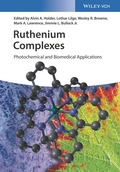Ruthenium Complexes
Photochemical and Biomedical Applications

1. Auflage Januar 2018
344 Seiten, Hardcover
180 Abbildungen (30 Farbabbildungen)
Monographie
Kurzbeschreibung
Edited by a team of highly respected researchers combining expertise in chemistry, physics, and medicine, this is a detailed discussion of the major concepts, underlying mechanisms, and the use of ruthenium complexes as catalysts for hydrogen production and in medicine.
Edited by a team of highly respected researchers combining their expertise in chemistry, physics, and medicine, this book focuses on the use of rutheniumcontaining complexes in artificial photosynthesis and medicine.
Following a brief introduction to the basic coordination chemistry of ruthenium complexes and their synthesis in section one, as well as their photophysical and photochemical properties, the authors discuss in detail the major concepts of artificial photosynthesis and mechanisms of hydrogen production and water oxidation with ruthenium in section two. The third section of the text covers biological properties and important medical applications of ruthenium complexes as therapeutic agents or in diagnostic imaging.
Aimed at stimulating research in this active field, this is an invaluable information source for researchers in academia, health research institutes and governmental departments working in the field of organometallic chemistry, green and sustainable chemistry as well as medicine/drug discovery, while equally serving as a useful reference also for scientists in industry.
2) Coordination Chemistry of Ruthenium
3) Photophysics and Photochemistry
4) Artificial Photosynthesis
5) Ruthenium-Containing Complexes with Cobalt and Hydrogenases for Hydrogen Production
6) Ligand Photosubstitution Reactions with Ruthenium Compounds: Applications in Chemical Biology and Medicinal Chemistry
7) Ruthenium Complexes in Photodynamic Therapeutics: State of the Art and New Trends
8) Photodynamic Therapy in Medicine with Mixed-Metal/Supramolecular Complexes
9) From Ru(III) Plasma Protein Binding Agents to Targeted Tumor Delivery
10) Design Aspects of Ruthenium Complexes as DNA Probes and Phototherapeutics
11) Ruthenium-Based Anticancer Compounds: Insights into their Cellular Targeting and Mechanism of Action
12) Ruthenium Complexes in Imaging Applications
13) Biological Activity of Ruthenium Complexes with Anti-Bacterial and Anti-Malarial Drugs
14) Ruthenium Complexes as NO Donors. Perspectives and Photobiological Applications
15) Trends and Future Developments of Ruthenium Anticancer Compounds
16) Ruthenium Complexes as Anti-Fungal Agents
Lothar Lilge is a senior scientist at the Princess Margaret Cancer Centre and holds a professorship at the University of Toronto, Canada. He obtained his Diploma in physics from the Johann Wolfgang Goethe University in Frankfurt, Germany, and his Ph.D. degree in biophysics from the Westfaehlische Wilhelms University in Muenster, Germany. Additional training was provided through the Wellman Laboratories of Photomedicine at Massachusetts General Hospital, Boston, USA, and during a post-doc at McMaster University in Hamilton, Canada. His work is focused on photodynamic therapy including the use of ruthenium-based photosensitizers and optical spectroscopy for diagnostic and risk assessment among a range of other biophotonic application in medicine.
Wesley R. Browne is an associate professor at Stratingh Institute for Chemistry at the University of Groningen, The Netherlands, since 2013. He completed his Ph.D. degree at Dublin City University, Ireland, with Prof. J. G. Vos in 2002, followed by a postdoc under the joint guidance of Prof. J. G. Vos and Prof. J. J. McGarvey, Queens University Belfast, UK. Between 2003 and 2007 he was a postdoctoral research fellow in the group of Prof. B. L. Feringa at the University of Groningen. He was appointed assistant professor in 2008. His current research interests include transition metal based oxidation catalysis, electrochromic materials and responsive surfaces. He is an advisory board member for the European Journal of Inorganic Chemistry, Particle & Particle Characterization (both Wiley) and Chemical Communications (RSC). He has (co-)authored over 150 research papers, reviews and book chapters.
Mark A. W. Lawrence was a post-doctoral fellow at Old Dominion University in Norfolk, USA, in the group of Prof. A. Holder. He received his B.Sc. degree in 2006 and his Ph.D. degree in inorganic-physical chemistry in 2011 from the University of the West Indies (UWI), Mona Campus, Jamaica, with Prof. Tara P. Dasgupta. His research interests include synthesis of hydrazones and functionalized pyridyl benzothiazoles, their transition metal complexes and application to catalysis and biological processes.
Jimmie L. Bullock Jr. is a Ph.D. student at the University of Kentucky in Lexington, USA, in the department of Chemistry. He received his B.Sc. degree from Longwood University, Farmville, USA, and his M.S. degree in biological inorganic chemistry from Old Dominion University, Norfolk, USA, in 2013 and 2016, respectively. His research interests include studying activation of signaling pathways induced by non-platinum based chemotherapeutic agents and synthesis of lanthanide sensor molecules.


